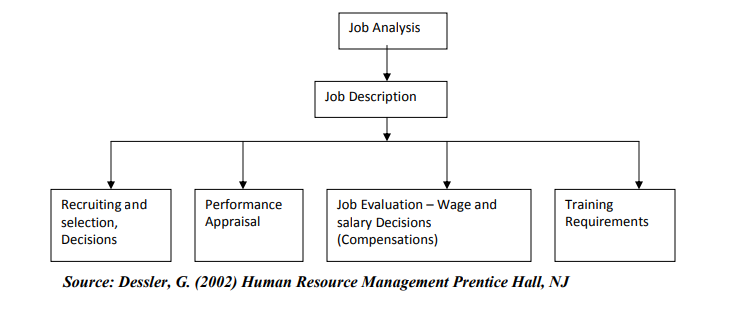Job analysis, as summarized in figure 2.1, is the basic for several inter-related HR management activities.

Uses of Job Analysis Information
Recruitment and Selection: Job analysis provides information about what the job entails and what human characteristics are required to perform these activities. This information, in the form of job description and specifications, helps management decide what sort of people to recruit and hire.
Compensation; Job analysis information is crucial for estimating the value of each job and is appropriate compensation. Compensation (such as salary and bonus) usually depends on the job’s required skill and level, safety hazards, degree of responsibility and so on – all factors you can assess through job analysis. Furthermore, many employers group jobs into classes (say, secretary III and IV). Job analysis provides the information to determine the relative worth of each job and thus appropriate class.
Performance Appraisal: A performance appraisal compares each employee’s actual performance with his or her performance standards. Mangers use job analysis to determine the job’s specific activities and performance standards.
Training: The job description should show the activities and skills – and therefore the training – that the job requires.
Discovery Unassigned Duties; Job analysis can also help reveal unassigned duties. For example, your company’s production manager says she’s responsible for a dozen or so duties, such as production scheduling and raw material purchasing. Missing, however, is any reference to managing raw material inventories? On further study, you learn that none of the other manufacturing people are responsible for inventory management, either. You know from your review of other jobs like these that someone should be managing inventories. You’ve uncovered an essential unassigned duty, thanks to job analysis.
EEO Compliance: job analysis also plays a big role in EEO compliance. Job analysis is a crucial in validating all major personnel activities. For example employers must be able to show that their selection criteria and job performance are actually related. Doing this, of course requires knowing what the job entails which in turn requires a job analysis.
Steps in Job Analysis
There are six steps in doing a job analysis.
Step 1: Decide how you’ll use the information since this will determine the data you collect and how you collect them. Some data collection techniques like interviewing the employee and asking what the job entails are good for writing job descriptions and selecting employees for the job. Other techniques like the position analysis questionnaire described later do not provide qualitative information for job descriptions. Instead they provide numerical ratings for each job; these can be used to compare jobs for compensation purposes.
Step 2: Review relevant background information such as organization charts, process charts and job descriptions. Organizational charts show the organization wide division of work how the job in question relates to other jobs and where the job fits in the overall organization. Should also show distribution of work, with whom the job incumbent communicates. A process chart provides a more detailed picture of the workflow. It shows the flow of inputs to and outputs from a particular job being analyzed.
Step 3: Select representative positions. Why? Because there may be too many similar jobs to analyze. For example, it is usually unnecessary to analyze the jobs of 200 assembly workers when a sample of 10 jobs will do.
Step 4: Actually analyze the job – by collecting data on job activities, required employee behaviours, working conditions and human traits and abilities needed to perform the job. For this step use one or more of the job analysis methods explained later in this lesson.
Step 5: Verify the job analysis information with the worker performing the job and with his or her immediate supervisor. This will help confirm that the information is factually correct and complete. This review can help gain the employee’s acceptance of the job analysis data and conclusions; by giving that person a chance to review and modify your description of the job activities.
Step 6: Develop a job description and specification. These are two tangible products of the job analysis. The job description is a written statement that describes the activities and responsibilities of the job, as well as its important features, such as working conditions and safety hazards. The job specification summarizes the personal qualities, traits skills and background required for getting the job done. It may be in a separate document or in the same document as the job description.